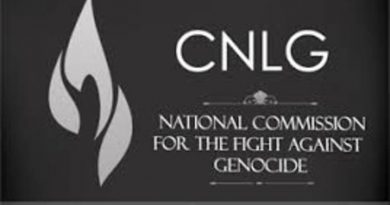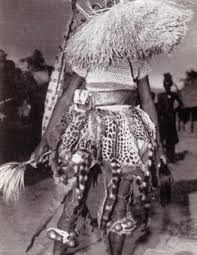APRIL 14, 1994: THE IMPLEMENTATION OF THE PERPETRATED GENOCIDE AGAINST TUTSI THROUGHOUT THE COUNTRY
On April 14, 1994, the criminal government continued to implement its genocidal plan to exterminate Tutsi throughout the country. As part of remembering the victims of the Genocide perpetrated against the Tutsi, the National Commission for the Fight against Genocide (CNLG) continues to recall the history of this Genocide, how it was implemented on a daily basis, and below how it was executed across the country on April 14, 1994.
1.The massacres of Tutsi in Muhima / Nyarugenge
On the morning of April 14, 1994, the population of part of the Muhima district, below the former Nyarugenge prison, in the Umwezi village in the former Ruhurura cell, Interahamwe and soldiers gathered Tutsis there, brought these below at a place which was called "Staircase" where the Tutsi, while they were going down, were cut with a machete, their heads smashed on the asphalt road or killed with a gun.
A large number of Tutsi were killed there, on this road had been installed a barrier where those who crossed the tarmac road were arrested and killed when they were Tutsi, after which the bodies of the victims were piled up at the side of the road. So far, what has grieved the families of the victims is that these bodies have never been found for burial with dignity.
Among the Interahamwe who participated in these massacres, there is their leader, Ndemeye Nicodème, Gashayija Etienne, the named Charles, Rurangirwa Jean Paul who was sentenced to life imprisonment for the crime of genocide, and who is currently serving his sentence in prison. Mageragere.
2.The massacres of Tutsis who had taken refuge at the Deutsche Welle Kinyinya, Gasabo / Kigali
On April 14, 1994, in the Kinyinya Sector, nearly 200 Tutsi took refuge in the buildings of the German radio Deutsche Welle located in Kinyinya, because they believed they were finding protection there. The soldiers of the Kami camp sent a warning to the Deutsche Welle, informing them that they had learned that they were hiding Tutsis and asking to drive them out. The Germans did not dare to hunt the Tutsi and when they were evacuated, they left the guard of their buildings to Uwimfura Callixte, one of their employees. As soon as this employee made sure that the Germans had taken their plane, he hastened to call the other Interahamwe of Kinyinya so that they came to help him kill the many Tutsis who were at Deutsche Welle. These were all killed apart from 3 survivors.
In Kinyinya, and long before the outbreak of the Genocide on April 7, 1994, there were two particularly formidable Interahamwe: Uwimfura Callixte and Chief Warrant Officer Zirimwabagabo, instructor of the Interahamwe. Zirimwabagabo used to buy his beer when he went to a bar, which he first gave his dog to lick, and then invited a Tutsi to drink this beer; when he refused, he was beaten until he had broken ribs and became disabled. There are 441 Tutsis who were killed at the Deutsche Welle and who could be identified.
3.The massacres of Tutsi at ADEPR Maheresho, Nyamagabe
On April 14, 1994, the Tutsi massacres began in Maheresho where victims were killed by Interahamwe and gendarmes called for this purpose by Hategekimana Didas, Mayor of the Rukondo Commune. That day, at the home of the parents of the Minister of Agriculture and Livestock, Nzamurambaho Frédéric, who was also among the leaders of the PSD, more than 37 Tutsi who had fled there hoping to find safety there, were killed.
Among those responsible for this massacre is Bourgmestre Hategekimana Didace, Munyambuga Jean Baptiste, MDR representative in Rukondo Commune, his son Twagiramungu Jean leader of the Interahamwe youth, Kagimbura Martin deputy president of MDR in Rukondo commune and teacher, Munyandinda Joen inspector primary school Rukondo, Nyagatare Cyprien teacher, Bikorimana Gaspard teacher, Hakizayezu Jean, Gashugi, Bukeye Alphonse and others. The massacres were committed by these killers and gendarmes who had come from Gikongoro.
4.The massacres of Tutsi who had taken refuge at the Mata tea factory, Nyamagabe
On April 14, 1994, the Tutsi who had taken refuge at the Mata tea factory and others who lived nearby, began to be massacred. The victims who have been identified and whose bodies lie at the genocide memorial of this factory are 380.
Among those responsible for these massacres, there is the Sous-préfet of Munini, Biniga Damien, Ndabarinze Juvenal, Director of the Mata factory, Mugirangabo Silas, Mayor of the Rwamiko Commune, Hakizimana Sylvestre, president of MDR Power in the Commune Rwamiko, Surwumwe Sylvestre, chairman of the MRND, Muriro, chairman of the CDR, Museruka, OPJ in the Rwamiko Commune and other Interahamwe.
5.The massacres of Tutsis who had taken refuge in Gati Sector, Rwamagana
On April 14, 1994, Tutsi were killed in the Gati Sector, in the Rwamagana District. The massacres were directed by Rutagengwa Jean Marie Vianney who directed the MRND. It was he who incited to kill the Tutsi in Gati. The Interahamwe whom he led asked him for permission to check on Consesa Mukandori, a Tutsi, what the brains of the Tutsi look like; he gave them authorization and the Interahamwe cut off the victim's head and cut off the victim to examine the brain; Rwabukame, Consesa's husband, was also immediately killed. Among the killers were Bigabiro Joshua, Kabugari, Nibivugire and the one who was the director of the school of Gati.
6.The massacres of Tutsi in Birambo, Karongi
On April 14, 1994, the Tutsi who had taken refuge in the school of the Birambo sisters community were attacked by Interahamwe, soldiers and gendarmes, led by the Mayor of the Bwakira Commune, Kabasha Tharcisse. They were killed with a gun, machete, spears, grenades and others.
More than 5,000 Tutsi were killed there. Numerous bodies of the victims were burned with gasoline, and devices were brought in to dig pits in which the bodies of the victims were buried near the school buildings. As the bodies had become too numerous, another grave was dug near the Urumuri school. It was traders' vehicles which transported these bodies to the pits.
7.The massacres of Tutsi at the Catholic church in Kibeho, Nyaruguru
On April 14, 1994, at the Kibeho church, the Interahamwe and local authorities exterminated more than 25,000 Tutsi who had taken refuge at the church and in the buildings of the Kibeho Parish. The Tutsi first defended themselves using the weapons within their reach, and were able to repel the attack of April 12, 1994. The Interahamwe of Kibeho went to seek reinforcements and the authorities of the Sous-préfecture of Munini helped them to mobilize gendarmes and other Interahamwe from Mata, Ruramba, Mudasomwa and elsewhere, who attacked the Tutsi refugees with firearms and grenades.
The attack began at 1 p.m. and lasted until evening. Father Pierre Ngoga asked the survivors of these massacres to consider how to flee to Burundi, and took some in his vehicle and brought them to Butare, where he was assassinated, betrayed by his colleague, Father Anaclet Sebahinde, who was originally from Kibeho.
Among the killers of Kibeho there is the Sous-préfet Damien Biniga, the Bourgmestre of Mubuga Charles Nyiridandi, the Bourgmestre of Rwamiko, Silas Mugerangabo, Juvénal Ndabarinze, director of the Mata tea factory, the agronomist Bakundukize Innocent, Father Emmanuel Uwayezu who directed the Marie Merci school group from Kibeho and the municipal police officer Athanase Saba.
8.The massacres of Tutsi in the Munyiginya / Rwamagana sector
In the Munyiginya Sector, the place called Sayi is located at the crossroads of the power lines that serve the District of Rwamagana. In 1994, the place was heavily guarded by gendarmes. When the Genocide broke out, the Tutsi from Munyiginya took refuge in Sayi, hoping that the soldiers who guarded the place would protect them. From 10 to 12 April 1994, many Tutsi, including women and children, took refuge there and more than 100 of them were killed.
During the night of April 14, 1994, the Tutsi who had taken refuge there were killed by the Interahamwe and the soldiers who were there helped them in their sinister task.
9.The massacres of Tutsi in the Kibungo sector, Ngoma
On April 14, 1994, around 8 a.m., a group of Interahamwe killers armed with various weapons entered the hospital in Kibungo and brought out those who had hidden there, from the maternity ward, and sit under a tree in a place called “Muduha” until 10 am. At this time the Tutsi were not killed, their torturers wanted to know the number to come back later to massacre them. At around 3:00 p.m. the Interahamwe returned and began killing Tutsi refugees, notably throwing grenades at them, as they did against those who had taken refuge in the Birenga Commune office.
The next day, April 15, 1994, a group of killers led by the fearsome Interahamwe Cyasa who sent teams to kill in different places: at the hospital, in Rukira, at the Economat and elsewhere. The Interahamwe Shumbusho, Birasa and others boasted of their sinister exploits at Birenga Commune and at the Economat General. The Interahamwe killed those in the hospital, including Marie from Gatare and her little sister Nyirankware, Mukankuranga and others who had come from Kazo and Karama.
On April 21, 1994, RPF Inkotanyi troops arrived at the hospital and were able to rescue the few survivors. The Inkotanyi brought other survivors to Kibungo hospital to provide them with the necessary care.
10.The massacres of Tutsi at the Ngoma / Nyamasheke primary school
On April 14, 1994, at Ngoma Primary School, there was a barrier and a 15m deep pit. Tutsis from this sector were rounded up and brought to this school to be put to death there, after Prefect Bagambiki Emmanuel went around Cyangugu to urge the Hutus to kill the Tutsis. The Tutsi who were killed there came mainly from the Ngoma Sector, especially from the Keshero Cell. They were surrounded and brought to the barrier to be killed. Among the killers, the Interahamwe Mazera, Ndayishimiye Emmanue, Bazambanza and others.
The Tutsi experienced an atrocious death because many men were first emasculated and their arms cut with a machete, when others were enucleated, the women were raped, the young children were taken from their mothers' arms and thrown away living in the pit; day and night you could hear the screams and tears of the children dying there.
Conclusion
The Genocide against the Tutsi was planned and carried out by the state. The fact that since the morning of April 7, 1994, the Tutsi were at the same time massacred throughout the country, from Kigali, and elsewhere, demonstrates without the slightest doubt that the Genocide was planned by the State Rwandan.
Done in Kigali, on 14/04//2020
Dr Bizimana Jean Damascène
Executive Secretary
National Commission for the fight against Genocide, CNLG



 Menya amateka ya ÔÇ£shuga mamiÔÇØ wa mbere witwa Nyirarunyonga
Menya amateka ya ÔÇ£shuga mamiÔÇØ wa mbere witwa Nyirarunyonga
